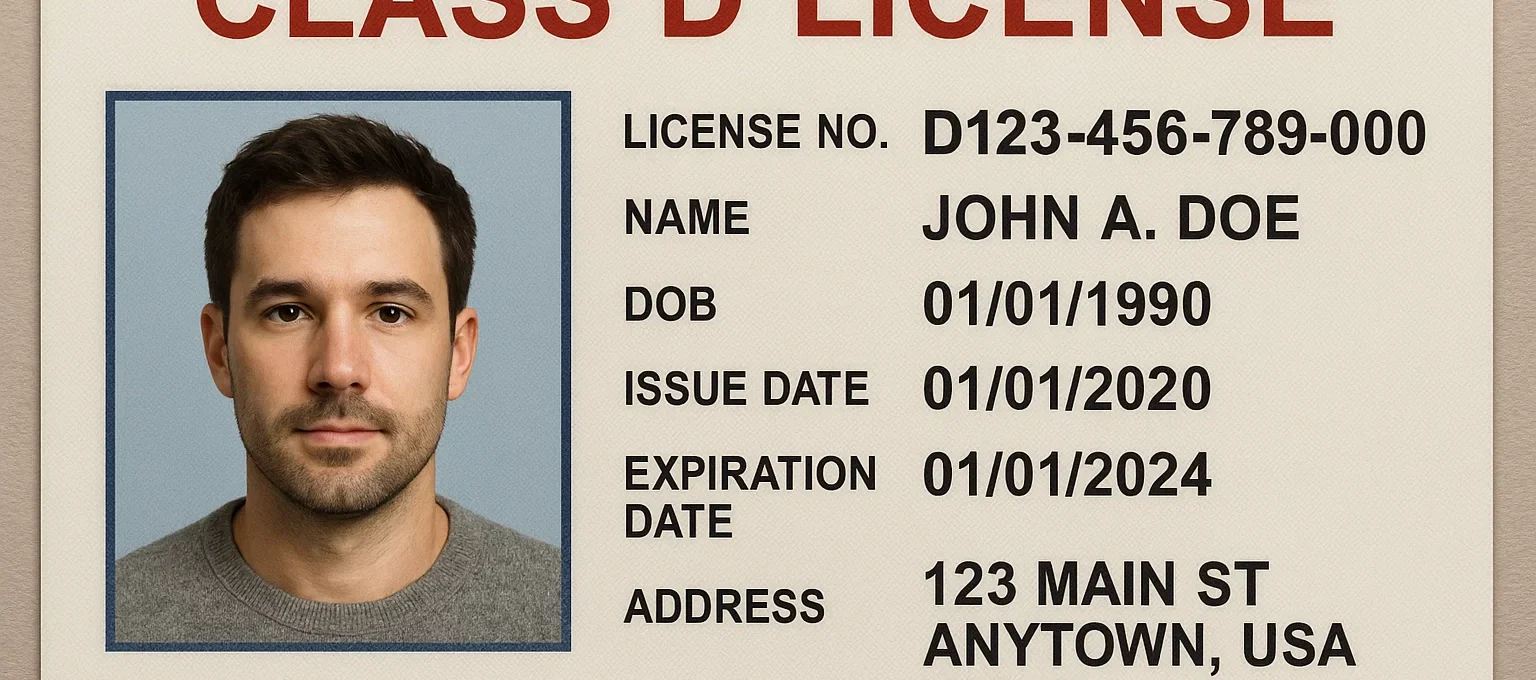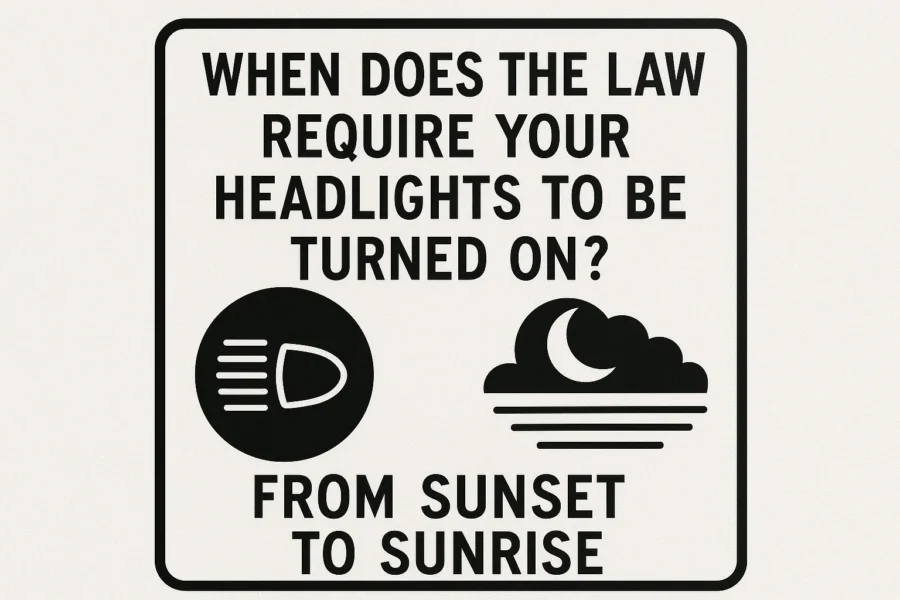Table of Contents
We know getting a Class D license can seem simple. But many people have questions about it. What is Class D License? It is the most common type of driver’s license in the United States.
We see it allows driving regular cars and light trucks. This license fits everyday needs for most drivers. In this article, we cover all details.
We aim to help you understand fully. From basics to rules in different places. Keep reading for clear facts.
What is a Class D License?
We start with the basics here. What is Class D License? It is a non-commercial driver’s license for standard vehicles.
Definition and Purpose
A Class D license lets you drive passenger vehicles. These include cars, vans, and small trucks. The purpose is safe driving on public roads.
It covers vehicles under 26,000 pounds gross vehicle weight rating. You cannot drive heavy trucks or buses with it. This keeps roads safe for all.
We note it is for personal use, not for hire. Many states call it the regular driver license. It helps with daily tasks like going to work.
Common Characteristics
Class D licenses share key features across states. They require a knowledge test and driving test. Vision screening is also needed.
Most allow towing trailers up to 10,000 pounds. But check state rules for exact limits. This license is the common type for adults.
We see it includes recreational vehicles sometimes. Like small campers under weight limits. Always confirm with your local motor vehicle office.
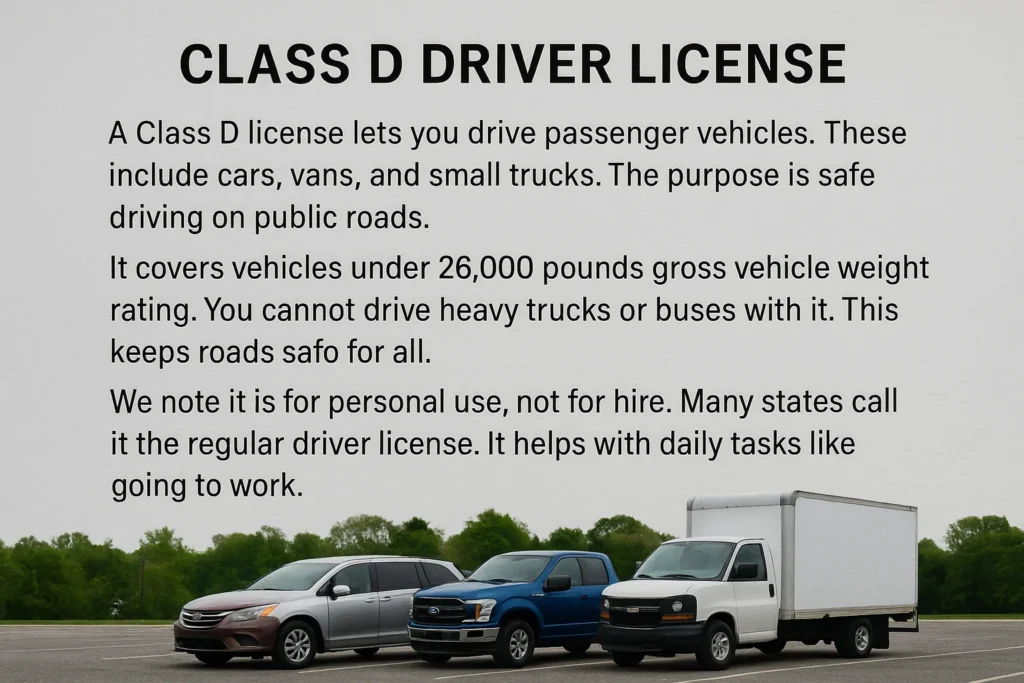
How is a Class D License Different from Other Licenses?
We compare it to others now. This shows what makes Class D unique. Understanding helps avoid mistakes.
Comparison with Commercial Driver’s Licenses (CDLs)
Class D is non-commercial. Unlike Class A CDL, which is for heavy vehicle combinations. Those weigh over 26,000 pounds gross combination weight rating.
Class B CDL covers single heavy vehicles. Like dump trucks without trailers. Class C CDL is for vehicles with hazardous materials or many passengers.
We point out CDLs need more tests. They include endorsements like H endorsement for hazmat. Class D does not require these.
Differences from Motorcycle and Moped Licenses
Class M is for motorcycles and motor-driven cycles. It needs a separate motorcycle instruction permit. Class D does not cover two-wheel vehicles.
For mopeds, some states allow Class D. But others need a special endorsement. We advise checking your state for low-speed vehicles.
Motorcycle licenses focus on balance and safety. Class D is for four-wheel stability. This split keeps training specific.
Requirements for Obtaining a Class D License
We explain how to get one. Steps are clear and standard. Follow them to drive legally.
Age Requirements
Most states set the age at 16 for a junior license. Full Class D comes at 18. Some offer Class D provisional license for teens.
We see variations by state. Like Georgia with Joshua’s Law for training. Age ensures maturity for safe driving.
For adults, no upper limit exists. But renewals may need extra checks. This keeps drivers fit.
Written and Vision Tests
A knowledge test covers rules and signs. Study the driver’s manual first. Pass it to get an instruction permit.
Vision screening checks your eyesight. It ensures clear sight for roads. Fail it, and you need glasses or contacts.
We recommend practice tests online. They help you prepare well. Tests are in simple English.
Practical Driving Exam
The driving test shows your skills. It includes parking and turns. An examiner watches your moves.
Practice with a certified instructor. Driver training schools offer help. Pass to get your license.
We suggest calm nerves during the exam. Follow all rules shown. Success leads to freedom on roads.
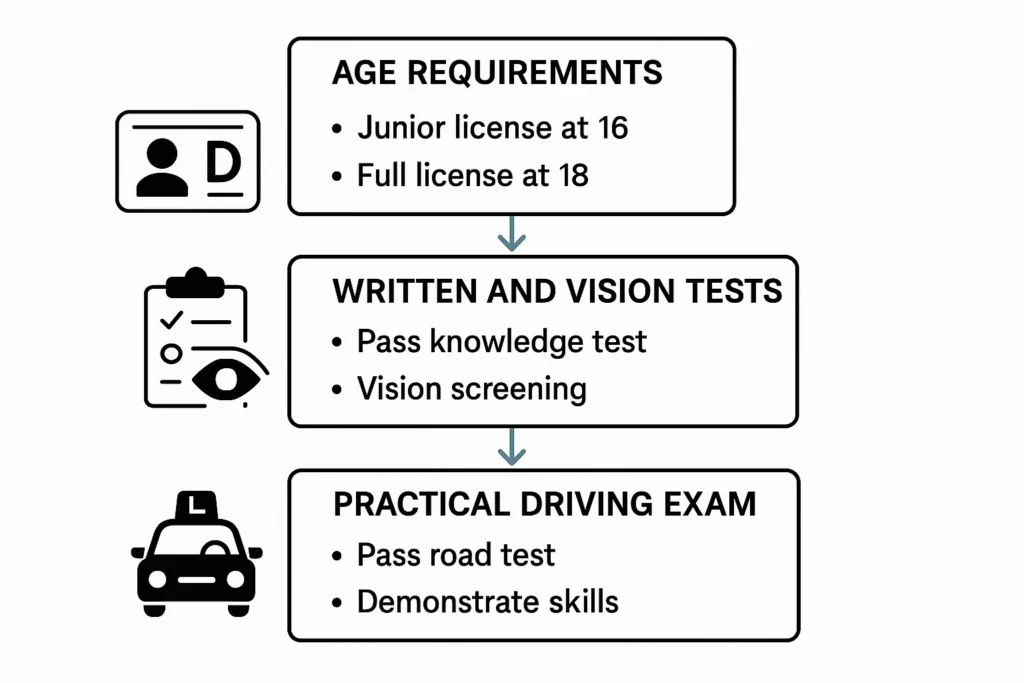
State-Specific Regulations and Variations
We cover differences by state. Rules change across the US. Know your area’s needs.
Variations in Testing Procedures
Some states like Massachusetts use RMV-issued tests. They include vehicle systems checks. Others have online options.
In Arizona, Travel ID meets REAL ID standards. It needs extra docs like birth certificate. Tests adapt to local needs.
We note Iowa requires an approved driver education course. This includes classroom and road time. Variations keep standards high.
State-Specific Documentation Required
Bring proof of identity always. Like social security number or US passport. Immigration status matters for non-citizens.
States like New York need marriage certificate sometimes. For name changes. We list common docs in a table below.
Motor vehicle report shows your history. Bring it if moving states. This speeds the process.
| Document Type | Examples | Purpose |
|---|---|---|
| Identity Proof | Birth Certificate, US Passport | Verify who you are |
| Residency Proof | Utility Bill, Lease | Show where you live |
| Legal Status | Social Security Number, Immigration Docs | Confirm US citizen or status |
| Name Change | Marriage Certificate | Update records |
Restrictions and Endorsements
We discuss limits and add-ons. These shape what you can do. Understand to stay legal.
Standard Limitations of a Class D License
No commercial use allowed. Like driving city buses or taxis. Class D bans hazardous materials too.
Weight limits apply strictly. Over 26,000 pounds needs CDL. Towing has caps as well.
We warn about junior restrictions. No night driving for teens. Or limited passengers.
Additional Endorsements and Their Implications
P endorsement adds passenger carry. But for non-commercial only. S endorsement is for school buses in CDL.
N endorsement covers tank vehicles. X endorsement combines hazmat and tank. These are for CDLs mostly.
T endorsement allows double trailers. In Class A. We see endorsements need extra tests.
Renewal and Maintenance of a Class D License
We guide on keeping it current. Renew on time to avoid issues. Simple steps help.
Renewal Process Overview
Most renew every 4 to 8 years. Online or in person at DMV. Pay driver’s license fees.
Vision test may be needed again. Update photo too. We suggest early action.
States like Tennessee offer regular driver license renewal. Check mail for notices. Stay informed.
Handling Expired Licenses
If expired, retake tests sometimes. Grace periods exist in some states. Act fast to fix.
We advise not driving expired. Fines can hit hard. Renew before due date.
For long expired, full process repeats. Like new applicant. Avoid this hassle.
Updating Personal Information
Change address within days. Use online forms or visit office. Keep records current.
Name changes need docs. Like court order. We see this for marriage or other reasons.
Update for accuracy. It helps with mail and checks. Simple but important.
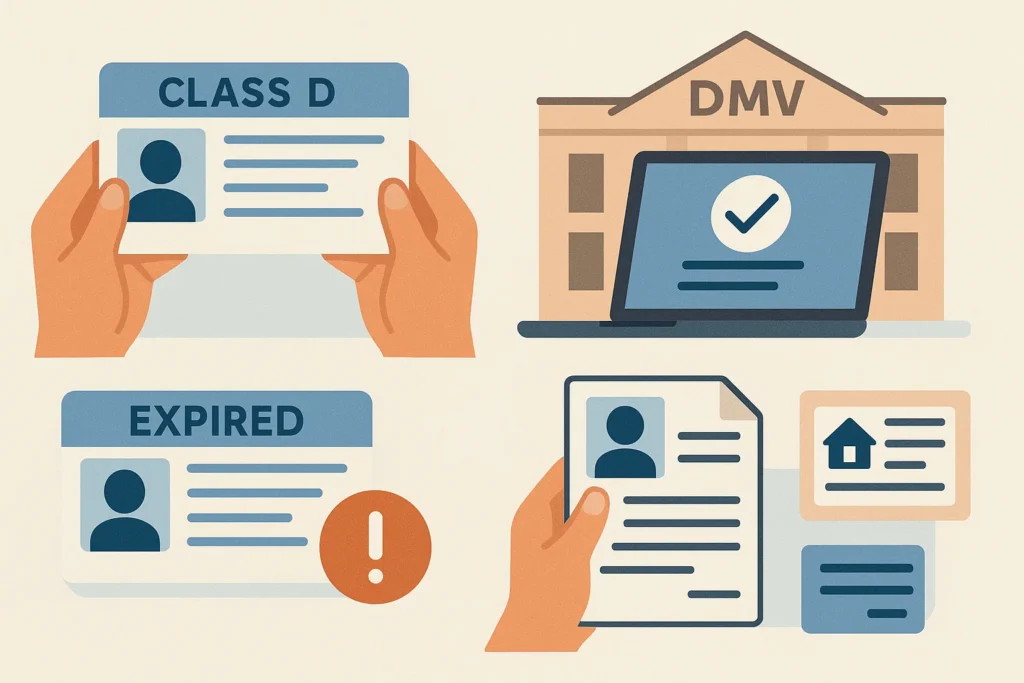
Why Understanding Class D Licenses is Important
We end with key reasons. Knowledge prevents problems. Drive with confidence.
Ensuring Compliance with Regulations
Follow rules to stay safe. Know limits like no heavy vehicles. This matches state laws.
We note REAL ID-compliant cards help. For flights and federal buildings. Like military bases or nuclear power plants.
Compliance avoids stops. Understand classes like Class A, Class B. Stick to yours.
Avoiding Legal Penalties
Break rules, face fines or loss. Like driving without endorsement. Penalties hurt wallet and record.
We warn about scams too. Text smishing scams fake DMV sites. Avoid fake websites.
Legal driving protects you. Know fees and forms. Like driver’s license forms.
In busy city life, right license matters. For public road use. Stay legal always.
We add that in other countries, classes differ. In the United Kingdom, Category D is for buses. It allows driving vehicles with more than 8 passenger seats.
In Norway, Category D lets you drive buses over 8 meters. You can tow trailers up to 750 kg. Minimum age is 24, or less with professional training.
Australia uses classes like C for cars. No direct Class D. But heavy vehicles have MR or HR.
We see global variations. US focuses on non-commercial for Class D. UK and Norway use D for buses.
For jobs, wrong license can lead to issues. Like in transport. But layoffs happen for other reasons.
From BBC news, layoffs come from financial uncertainty. Declining revenues cause cuts. Over-hiring in pandemic leads to adjustments.
Economic slowdown hits companies. Cost-cutting saves money. Tech firms see this often.
Announcing redundancies signals trouble. Workers quit fearing next. Policies use tenure for decisions.
Middle managers get hit hard. Short-sighted cuts affect teams. Diversity suffers too.
We tie this back: right license aids job hunt. In driving roles. Avoid penalties that harm work.

